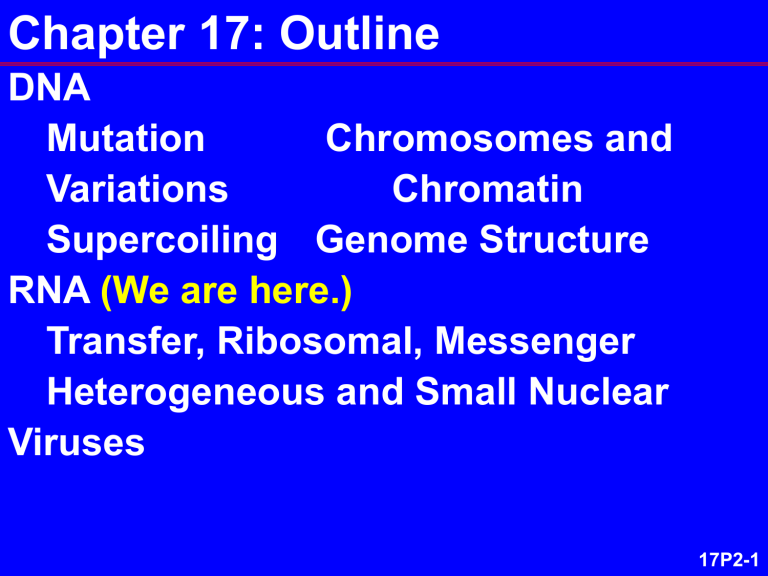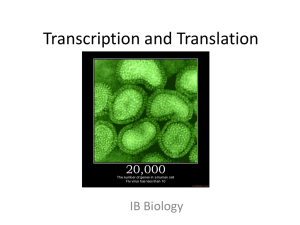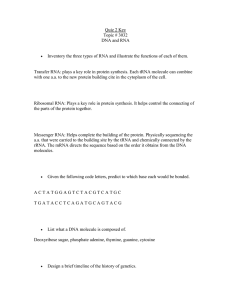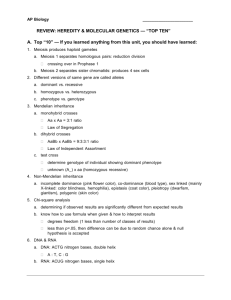Chapter 17: Outline

Chapter 17: Outline
DNA
Mutation
Variations
Chromosomes and
Chromatin
Supercoiling Genome Structure
RNA (We are here.)
Transfer, Ribosomal, Messenger
Heterogeneous and Small Nuclear
Viruses
17P2-1
17.2 Kinds of RNAs
transfer RNA (tRNA) transfers amino acids to the site of protein synthesis (ribosomes) ribosomal RNA (rRNA) rRNA forms ribosomes by reacting with proteins messenger RNA (mRNA) mRNA directs the AA sequence of proteins
17P2-2
tRNA
There is at least one tRNA (and often several) for each AA to be incorporated into a protein.
tRNA is single stranded with typically about 75 nucleotides.
Intrachain hydrogen bonding (A=U and
G=C) occurs to gives regions called stems with an a
-helix
The overall structure is called a cloverleaf in a L-shaped conformation.
17P2-3
tRNA-2
Two structural motifs in tRNA allow it to perform its critical function.
The 3’ terminus forms a covalent bond with a specific amino acid.
The anticodon loop contains a threebase-pair sequence complimentary to the DNA triplet code for an amino acid.
17P2-4
tRNA-3
tRNA also has:
A D loop (contains dihydrouridine)
A T
Y
C loop which contains the base sequence thymine, pseusouridine, cytosine.
A variable loop with usually 4-5 nucleotides but up to 20.
The features above presumably relate to binding to a protein or to the ribosome.
17P2-5
tRNA: cloverleaf; “L” model
Attachment to mRNA here
AA attaches here
Stem region
17P2-6
tRNA: Schematic View
Fig17.22b
17P2-7
rRNA
Ribosomal RNA is the most abundant form and makes up 80% cellular RNA.
Ribosomal RNA molecules are large and are found in the ribososmes.
Ribosome composition:
60-65% mass in rRNA
35-40% mass in protein
Ribosome subunits: two: a large and a small
17P2-8
Ribosomal subunits: 1
1. Small: 1 RNA + ~20 proteins
2. Large: 2 RNA + ~35 proteins
(procaryotes)
3 RNA + ~50 proteins (eucaryotes)
Subunits easily separated by lowering the Mg
2+ concentration.
Analytical ultracentrifuge separates subunits based on size and shape.
The Svedberg (S) measures the sedimentation coefficient of the subunit
17P2-9
mRNA
mRNA is the least abundant RNA (5-10%) mRNA is the carrier of the genetic message from DNA. A three base sequence on the mRNA codes for the
AA to be incorporated in the growing protein chain.
Shows frequent turnover.
Chain length varies with the length of the protein to be coded.
17P2-10
mRNA-2
Many prokaryotic mRNAs are polycistronic, they contain information for several poylpeptides. Eukaryotic mRNA is typically monocistronic.
Prokaryotic mRNAs are translated in to proteins immediately after synthesis but eukaryotic mRNAs are extensively processed before translation.
17P2-11
Other RNAs
Heterogeneous RNA (hnRNA) are the primary transcripts of DNA and the precursors of mRNA.
Small nuclear ribonuclearprotein particles (snRNP or “snurps”) are involved in splicing mRNA by removing the introns from the hnRNA.
17P2-12
17.3 Viruses
Viruses lack most properties that are associated with life.
A virus is a mobile genetic element.
A piece of nucleic acid with a protective coat.
It’s nucleic acid hijacks a cells machinery for making nucleic acids and proteins.
17P2-13
Viral Structure
Virons (complete viral particles) range from 10 to 400 nm in diameter.
A simple viron consists of:
Capsid: an interlocking protein coat
Most capsids are helical or icosahedral
Nucleic acid: DNA or RNA dsDNA, ssDNA, ssDNA, dsRNA
(most are double stranded DNA
(dsDNA))
17P2-14
Viral Structure-2
Two types of ssRNA genomes
1. Positive-sense acts as a giant RNA molecule and directs synthesis of long viral polypeptide which is cleaved to smaller pieces.
2. Negative-sense is complimentary in base sequence to the mRNA directing viral protein synthesis. (Need transcriptase enzyme)
In complex viruses, the nucleocapsid is surrounded by a membrane envelope.
17P2-15
Viral Structure-3
Representative viral structures.
17P2-16
The HIV Virus
HIV is a retrovirus that contains reverse transcriptase activity enabling it to make DNA from vRNA.
vDNA inserts into the host cell genome, destroying the immune system.
The next two slides depict the HIV virus and its life cycle.
17P2-17
Fig 17M
17P2-18
Fig 17N
17P2-19




